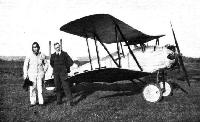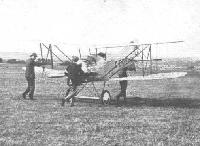
Flight, July 1920
The Olympia Aero Show 1920
The machines
Austin Motor Co., Ltd. (STAND 66) Longbridge Works, Northfield, Birmingham
ONE type of machine, the "Whippet," is being shown - one complete machine, and one "dissected" - by the Austin Co. The "Whippet" is a single-seater tractor biplane for civil use, suitable for business, sport and pleasure. It is essentially a one-man 'plane, being designed specially for the "owner-pilot," maintenance and flying being brought to the greatest degree of ease and simplicity. This is achieved in the "Whippet" by constructing the fuselage entirely of steel, and fitting streamlined steel struts in place of bracing wires, thus doing away with the necessity of constant rerigging. It also has folding wings - which are very securely locked in position when flying - enabling the machine to be housed in a shed 18 ft. long, 9 ft. wide and 8 ft. high. It is an easy machine to fly - it can be flown with "hands off" - and the landing speed as low as 35 m.p.h. The steel construction is also advantageous in tropical climates, apart from the question of strength and ability to withstand rough usage.
The engine is a 45-50 h.p. 6-cyl. radial Anzani, with which a maximum speed, at ground level, of 95 m.p.h. is obtained. The speed at 10,000 ft. is 80 m.p.h., and the climb to 5,000 ft. and 10,000 ft. is 9 mins. and 22 mins., respectively. The wings, which have a high factor of safety, are of standard construction, whilst the tail plane can be adjusted to suit different weights of pilots. An orthodox V-type landing chassis is fitted, and the tail skid is steerable, consisting of a compression spring working inside telescopic tubes; in order to give a good wearing surface, a special shoe is fitted, consisting of vertical laminated plates.
A comfortable seat is fitted, and the cowling and wind-screen are arranged so as to give complete protection to the pilot. A cupboard is provided under the seat for luggage and tools.
The Austin "Whippet"
On the Austin stand one sees examples of the one-man sporting type machine, in the design of which simplicity and ease of upkeep have been first considerations. It is quite certain that the "owner pilot" will not wish to be bothered with constantly having to make adjustments to his machine, such as stripping the covering off his fuselage to tighten up wires after a rough landing, or to be constantly going over his wings with plumb line, spirit level and incidence gauge. In the Austin "Whippet" a serious attempt has been made to obviate the necessity of these adjustments by so designing the machine that once erected and trued up, it is not likely to require much in the way of adjustment afterward, certainly not until after considerable use.
The manner in which this is brought about is, as regards the fuselage, to do away with all diagonal wire bracing. The four longerons are thin steel tubes, as are also the vertical and horizontal struts. The structure is kept in proper alignment by diagonal steel tubes attached to clips on the longerons, and made to exact length in the first place, so that once bolted up no further adjustment is necessary.
A similar method has been employed in the wing bracing. Instead of the ordinary lift and landing wires, two long tubes slope outward from the lower wing root to the top of the interplane struts. When the machine is in the air, these tubes are, of course, in tension, while when the machine is upside down or resting on the ground they are in compression. It is not anticipated that any adjustments will have to be made for long periods, but should this be necessary provision has been made, by a series of holes in the tubes and their sockets, to make easily and quickly any adjustment that might be required. Some of our sketches will help to explain the detail design.
A point which attracts special attention in this little machine is the fact that in spite of its small size, it is fitted with folding wings, a fact which should go a long way towards popularizing the Austin "Whippet," seeing that, when folded, it occupies little more space than an ordinary motor-car. As the engine is of low horse-power - 45-50 Anzani - the fuel consumption is low, and the running costs should be relatively small.
- Flight, July 1920
The Olympia Aero Show 1920
Фотографии
-
Aeroplane Monthly 1989-07 / P.Jarrett - Austin's Aerial Nippy
Регистрационный номер: K-158 [4], G-EAGS [4] Designer J. W. Kenworthy stands by the nose of prototype Whippet K-158. Capt Nares, Austin's test pilot, is in the cockpit.
-
Aeroplane Monthly 1989-07 / P.Jarrett - Austin's Aerial Nippy
Регистрационный номер: K-158 [4], G-EAGS [4] Austin’s first post-war aeroplane was the little Whippet of 1919, a single-seat sporting biplane designed by J. W. Kenworthy and powered by the 45 h.p. six-cylinder Anzani radial. Five Whippets were built, the first originally being registered K158 and later G-EAGS. The Whippet did away with bracing wires by the use of N-type interplane struts and streamlined steel lift struts.
-
Aeroplane Monthly 1989-07 / P.Jarrett - Austin's Aerial Nippy
Регистрационный номер: K-158 [4], G-EAGS [4] First Austin Whippet is standing alongside Handley Page O/400 J2251, one of a batch built by the Birmingham Carriage Co Ltd. This aircraft also joined the civil register, becoming HP-21/G-EALX with Handley Page Transport Ltd in October 1919, but was scrapped after a heavy landing in April 1921. Engines were two 360 h.p. Rolls-Royce Eagle VIIIs, which drove a pair of four-bladed propellers.
Другие самолёты на фотографии: Handley Page H.P.12 (O/400) - Великобритания - 1917
-
Flight 1924-11 / Flight
Регистрационный номер: G-EAPF [5] THE AUSTIN "WHIPPET": Fitted with a six-cylinder Anzani engine of 45 h.p. this machine has an excellent performance coupled with low landing speed. It is used by an Air Force Officer as a run-about, and has been in service for some four or five years.
-
Aeroplane Monthly 1989-07 / P.Jarrett - Austin's Aerial Nippy
Регистрационный номер: G-EAPF [5] Flt Lt F. O. Soden runs up Whippet G-EAPF at Gosport on King's Cup day, August 12, 1924.
-
Aeroplane Monthly 1989-07 / P.Jarrett - Austin's Aerial Nippy
Регистрационный номер: G-EAGS [4], K-158 [4] Whippet K-158 with its new permanent registration, G-EAGS, showing the wing folding.
The little machine is the Austin "Whippet" with 45-50 h.p. 6-cyl. Anzani, designed by John Kenworthy, who later produced the Redwing, and produced in 1919. This machine was the first post-war light plane, but it was, unfortunately, before its time, there was then no demand for such a machine, and it never went into quantity production. We believe the machine is still in existence, or was until quite recently. -
Aeroplane Monthly 1979-10 / D.Brown - Wings over Sussex (2)
Регистрационный номер: G-EAPF [5] The second Whippet at Stag Lane in 1923.
Austin Whippet G-EAPF was built by the Austin Motor Company Ltd in 1919. Bought by F. G. Miles, it languished at Shoreham until 1931. -
Aeroplane Monthly 1989-07 / P.Jarrett - Austin's Aerial Nippy
Регистрационный номер: G-EAPF [5] The second Whippet after being fitted with a 60 h,p, Anzani to improve performance. Note the circular exhaust system.
-
Flight 1925-08 / Flight
Регистрационный номер: G-EAPF [5] The Austin "Whippet" going out for the Private Owners' Handicap.
-
Aeroplane Monthly 1991-08 / M.Oakey - Grapevine
Nearing completion at Stoke-on-Trent is collector Ken Fern's Austin Whippet replica, inspired by Philip Jarrett's article on the aircraft in July 1989’s Aeroplane. Ken needs a suitable engine for it (the original had a six-cylinder Anzani).
-
Aeroplane Monthly 1989-07 / P.Jarrett - Austin's Aerial Nippy
The final Whippet shortly after completion. This aircraft was exported to New Zealand and the fuselage ended up in Australia, but it probably never flew "down under".
-
Flight 1927-09 / Flight
PRIVATE FLYING IN 1920: This Austin Whippet and B.E.2e, taken at Hendon in 1920, comprised the fleet owned by Mr. A. J. Greenshields, who is now in the Argentina, where he still flies the Austin Whippet as well as a Potez VIII two-seater fitted with a 70 h.p. Anzani engine. He is the only British private owner in that country
Другие самолёты на фотографии: RAF B.E.2e - Великобритания - 1916
-
Flight 1920-07 / Flight
THE AUSTIN "WHIPPET" AT OLYMPIA: This little machine has folding wings and occupies a very small space
-
Aeroplane Monthly 1989-07 / P.Jarrett - Austin's Aerial Nippy
Регистрационный номер: G-EAUZ A complete but uncovered Whippet airframe. This may well be G-EAUZ, the third machine, which was displayed at Olympia minus engine.
-
Aeroplane Monthly 1989-07 / P.Jarrett - Austin's Aerial Nippy
The prototype Austin Whippet, with original form of cowling covering the cylinder heads, and with wings folded.
-
Aeroplane Monthly 1991-04 / Skywriters
An Austin Whippet on its back in New Zealand.
-
Flight 1920-07 / Flight
SOME DETAILS OF THE AUSTIN " WHIPPET." On the left is shown the sprung tail skid, and on the right the body construction. The diagram in the centre shows the wing bracing
-
Flight 1920-07 / Flight
THE AUSTIN "WHIPPET": Left: Sketch showing the locking device for the folding wings. Right: The adjustment of the incidence tube on the Austin "Whippet" is by means of a series of holes
- Фотографии



















